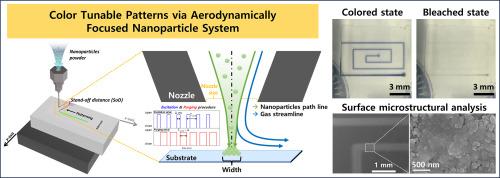Fabrication of color tunable patterns using aerodynamically focused nanoparticle system
IF 6.8
1区 工程技术
Q1 ENGINEERING, MANUFACTURING
引用次数: 0
Abstract
Additive manufacturing-based patterning technologies have been actively explored for achieving simpler and more efficient fabrication and overcoming limitations of conventional patterning methods such as complex multistep processes and generation of toxic byproducts. To address this need, a novel solvent-free patterning system called aerodynamically focused nanoparticle (AFN) system was developed. This system utilizes aerodynamic control for precisely directing nanoparticle flow, thereby eliminating the need for solvents and post-processing. The AFN system demonstrated its ability to fabricate fine lines with a microsized width, narrower than the nozzle used, by adjusting air pressures for the two-step excitation and purging process.
In this study, the microsized patterns of tungsten trioxide were fabricated using an AFN system to fabricate a color-tunable (electrochromic) pattern. The pattern width and height were optimized by adjusting the scan times and jet pressure and analyzed using optical microscopy, a surface profiler, and scanning electron microscopy. Furthermore, the electrochromic performance evaluation confirmed the durability of AFN-patterned tungsten oxide lines, maintaining their stable operation without cracking or delamination for up to 500 coloration/bleaching cycles. The effective width of the pattern for color tuning was measured to be ∼91 μm, which is ∼14 % of the inner diameter (640 μm) of the nozzle, demonstrating that AFN can form patterns to be significantly narrower than that of the nozzle size via aerodynamically focusing process. This study highlights the contribution of the AFN system to advance electrochromic device technology by providing a highly precise and solvent-free method for electrochromic pattern formation.

利用空气动力学聚焦纳米粒子系统制造颜色可调图案
基于增材制造的图形技术已经被积极探索,以实现更简单和更高效的制造,并克服传统图形方法的局限性,如复杂的多步骤过程和产生有毒副产物。为了满足这一需求,一种新型的无溶剂图案系统被称为空气动力学聚焦纳米颗粒(AFN)系统。该系统利用空气动力学控制精确定向纳米颗粒流动,从而消除了对溶剂和后处理的需要。AFN系统通过调整两步激励和净化过程的空气压力,证明了它能够制造出比所用喷嘴更窄的微细宽度的细线。在本研究中,使用AFN系统制备了三氧化钨的微尺寸图案,以制备颜色可调(电致变色)图案。通过调整扫描次数和喷射压力来优化图案宽度和高度,并使用光学显微镜、表面轮廓仪和扫描电镜进行分析。此外,电致变色性能评估证实了afn图案氧化钨线的耐久性,在多达500次着色/漂白循环中保持稳定运行,不会开裂或分层。颜色调整图案的有效宽度测量为~ 91 μm,是喷嘴内径(640 μm)的~ 14%,表明AFN可以通过空气动力学聚焦过程形成比喷嘴尺寸窄得多的图案。这项研究强调了AFN系统通过提供一种高精度和无溶剂的电致变色模式形成方法来推进电致变色器件技术的贡献。
本文章由计算机程序翻译,如有差异,请以英文原文为准。
求助全文
约1分钟内获得全文
求助全文
来源期刊

Journal of Manufacturing Processes
ENGINEERING, MANUFACTURING-
CiteScore
10.20
自引率
11.30%
发文量
833
审稿时长
50 days
期刊介绍:
The aim of the Journal of Manufacturing Processes (JMP) is to exchange current and future directions of manufacturing processes research, development and implementation, and to publish archival scholarly literature with a view to advancing state-of-the-art manufacturing processes and encouraging innovation for developing new and efficient processes. The journal will also publish from other research communities for rapid communication of innovative new concepts. Special-topic issues on emerging technologies and invited papers will also be published.
 求助内容:
求助内容: 应助结果提醒方式:
应助结果提醒方式:


